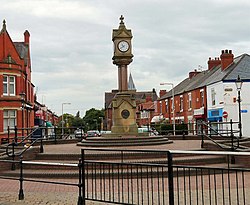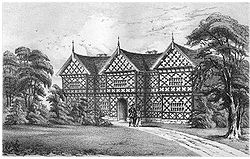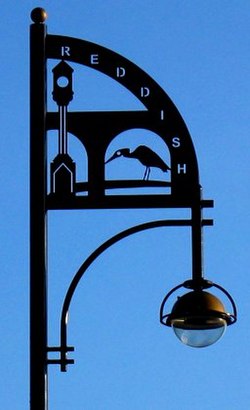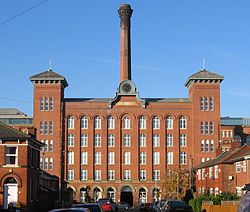Reddish
| Reddish | |
| Lancashire | |
|---|---|
 Houldsworth Square in central Reddish | |
| Location | |
| Grid reference: | SJ893935 |
| Location: | 53°26’18"N, 2°9’41"W |
| Data | |
| Population: | 28,052 (2011) |
| Post town: | Stockport, Manchester |
| Postcode: | SK5, M19 |
| Dialling code: | 0161 |
| Local Government | |
| Council: | Stockport |
| Parliamentary constituency: |
Denton and Reddish |
Reddish is a suburban area of south-east Lancashire, adjacent to the border with Cheshire. It is two miles north of Stockport in the latter county and four and a half miles south-east of Manchester in the former. The population is 30,055 in an area of 2¾ sq. miles.[1] By the UK Census 2011 the population of both wards (north and south) decreased to a combined total of 28,052.[2][3] Reddish grew and developed rapidly during the Industrial Revolution and still retains landmarks from that period, such as Houldsworth Mill, a former textile mill.
Reddish Vale is a country park close to the locality.
History
Toponymy
Reddish is recorded as Redich (1205, 1212), Redych, Radich (1226), Radish, Rediche (1262), Redditch (1381), Redwyche, Radishe and Reddishe (16th century).[4][5] The name either means "reedy ditch" (OE hrēod-dīc) or "red ditch" (OE rēad-dīc). Ekwall (1922) allows either form, stating "red" is less probable; Mills (1991) and Arrowsmith (1997) only give the "reed" option.[6][7][8] The ditch referred to is possibly the Nico Ditch,[7] an earthwork of uncertain origin bordering Reddish, Manchester and Denton.[9] Folklore has it that the names Gorton and Reddish arose from a battle between Saxons and Danes.[5][10][11] John Higson wrote in 1852[11]
The neigh'ring trench is called the Nicker Ditch
Flowing with blood, it did the name convey
To th' bordering hamlet, Red-Ditch. Near here, Where
the last 'tween the foes was fought,
Where victory was won, that memorable
Eminence proudly was distinguished
By the name of Winning Hill. The streamlet
Aforemention'd gains appellation
Of Gore Brook, also the contiguous
Happy hamlet through which it floweth still
Bears, in glorious commemoration,
And e'er shall, the honour'd name of Gore Town.
Farrer and Brownbill dismiss this interpretation as "popular fancy".[12]
1066 to late 18th century

Reddish does not appear in the Domesday survey; this is in common with most of the south-east Lancashire area.[13] A corn mill is known to have existed at the junction of Denton Brook and the River Tame from about 1400 onwards.[14] The two main mediæval houses were Reddish Hall at SJ899932 (demolished 1780,[4] but visible on maps dated 1840) and Hulme Hall at SJ889926, later known as Broadstone, then Broadstone Hall (demolished 1945[15]). The Reddish family were major landowners in the area from at least 1212 to 1613 when title passed by marriage to the Coke family. It passed down the family to Thomas Coke, 1st Earl of Leicester, who sold his land in Reddish at the end of the 18th century, and in 1808 it was bought by Robert Hyde Greg and John Greg.[4] There were Hulmes in Reddish in the 13th century, and the land passed through the family until about 1700 when it was given to a charitable trust.[4]
Very few buildings in Reddish pre-date the 19th century. Canal Bridge Farm, close to Broadstone Mill, is dated to the mid to late 18th century (the name is later).[16] Hartwell dates a small group of farm buildings and cottages at Shores Fold, near the junction of Nelstrop Road and Marbury Road, to the sixteenth and late seventeenth to early 18th century. These would have been on the traditional Reddish – Heaton Norris border, but are now firmly inside Heaton Chapel.[17]
Industrial Revolution
The Stockport Branch Canal passed through Reddish and opened in 1797. It seems to have had little effect by 1825, when Corry's description of Reddish, in full, was "The population of Reddish is but thin".[18] Booker states that in 1857 Reddish was almost entirely agricultural, being made of meadow and pasture (1,320 acres); arable land (90 acres); wood and water (50 acres); and buildings and streets (44 acres). At that time, Reddish contained "neither post-office, schoolmaster, lawyer, doctor, nor pawnshop".[19] The population increased over tenfold in the next fifty years with the Industrial Revolution.
The water-powered calico printworks in Reddish Vale on the River Tame is known to have been working before 1800. Industrial development followed the line of the canal[20] and was steam-powered throughout. A variety of manufacturers moved into Reddish during this period.
Robert Hyde Greg and John Greg, sons of Samuel Greg of Quarry Bank Mill, who owned about a third of Reddish by 1857,[21] opened Albert Mills for cotton spinning in 1845. Moor Mill, manufacturing knitting machines, was built around the same time. William Houldsworth's Reddish Mill for cotton spinning was opened in 1864. Hanover Mill was built in 1865 for cotton spinning, but in 1889 was converted to make silk, velvet, woven fur etc.
The Reddish Spinning Company, partly owned by Houldsworth, opened in 1870. Furnival & Co, making printing presses, opened in 1877.[22] Andrew's Gas Engine works opened in 1878.[23] The Manchester Guardian's printworks opened in 1899. Craven Brothers, a manufacturer of machine tools and cranes, opened the Vauxhall Works on Greg Street, in 1900.[24] Broadstone Spinning Company opened a large double mill in 1906/7. These major employers were accompanied by numerous smaller concerns, including dyeworks, bleachworks, wire ropeworks, brickworks, screw manufacturers, makers of surveying equipment, and a tobacco factory.[25]
A small number of closures of major industrial employers took place in the first half of the 20th century, due to the ebb and flow of trade. Andrew's Gas Engine Works was taken over in 1905 by Richard Hornsby & Sons of Grantham,[26][27] the business was transferred to Grantham and the Reddish works closed some time during the great depression following World War I.[27] Cronin indicates that the works were still in operation in 1930.[28] The Atlas wire rope works closed in 1927.[29]
Reddish took its share of the decline in Lancashire cotton production and finishing. Broadstone Mills ceased production in 1959;[30] Reddish Mills closed in 1958 with the loss of 350-400 jobs;[31][32] Spur Mill followed in 1972;[33] and the long-lived Reddish Vale printworks closed by 1975;[34] Albert Mill continued to trade as R. Greg and co under new ownership, but finally closed in 1982.[28] Ashmore wrote in 1975 that "Stockport has ceased to be a cotton town."[35]
The decline of Broadstone Mills was accompanied by high farce. In November 1958 the company sold a number of spinning mules as scrap for just over £3,000. By agreement, the machines remained in the mill over the winter. A small number had been broken and removed by April 1959, when the government announced a compensation package for firms that agreed to scrap spinning capacity. As the title in the mules had passed to the scrapman, it was decided that the company was not entitled to compensation amounting to over £60,000, despite the fact that the machinery was still on its premises. Actions in the High Court and the Court of Appeal in 1965 were fruitless.[36][37]
Some of the mills vacated by the spinners found other uses. The Reddish Spinning Company's mill was taken over by V. & E. Friedland who became the world's largest manufacture of doorbells; an extension to the mill won several architectural awards.[38] The mill is now residential. Broadstone Mill was partly demolished, but now houses small commercial units.[39] Regeneration efforts at Houldsworth Mill were instrumental in Stockport Council winning British Urban Regeneration Association's award for best practice in regeneration.[40] £12 million has been spent to convert the mill into mixed use.[41] The area around Houldsworth mill is now designated as a conservation area.[42][43]
Boundaries
The extents have been well-defined for at least several hundred years. Reddish originated as a township in the ancient parish of Manchester, but lay outside the Manor of Manchester. This had the effect that boundaries of Reddish were described by the boundaries of the Manor of Manchester, with the exception of the boundary with Cheshire, the River Tame. The manor boundaries were surveyed and recorded in 1322, and the relevant part was:[44]
following the said water [Tame] to the mid [stream] between the county of Chester and Assheton unto the Mereclowe at Redyshe so following Mereclowe unto Saltergate, from thence following the ditch of Redyshe unto Mikeldiche, following that unto Peyfyngate, following that unto Le Turrepittes between Heton Norreyes and Redishe, from thence following Le Merebroke unto the confluence of the waters of Tame and Mersey
"Mere" means boundary in this context. The description was traced into early 20th century features by Crofton[45][46] and can be cast as
following the middle of the Tame as far as Denton Brook at Reddish; and so following Denton Brook and a tributary as far as Thornley Lane South; and then following Thornley Lane as far as Nico Ditch; and following Nelstrop Road as far as the turf-pits between Heaton Norris and Reddish (these are lost); and from there following Black Brook as far as near the conjunction of the waters of the Tame and Goyt.
However, Black Brook cannot be le Merebroke as it does not flow to the Tame, but joins Cringle Brook, which flows into the Mersey several miles away via Chorlton Brook. With this exception, Crofton's interpretation of the 1322 boundaries matches those shown on Ordnance Survey maps of the 19th century.

Landmarks
Reddish is home to several listed buildings and structures.[47] All the Grade I and Grade II* listings are part of Houldsworth's community.

- Grade I
- St Elisabeth's Church & wall at St Elisabeth's Church (Grade II*)
- Grade II*
- Houldsworth Mill, Houldsworth Street. Designed by Abraham Henthorn Stott. Opened 1860s, closed as a cotton mill 1958.
- Houldsworth Working Men's Club, Leamington Road. Designed by Abraham Henthorn Stott. Opened 16 May 1874.
- St Elisabeth's C of E Primary School (Houldsworth School), Liverpool Street. Wall at St. Elisabeth's C of E Primary School, Liverpool Street. Designed by Alfred Waterhouse. Consecrated 1883.
- St. Elisabeth's Church Rectory & wall at St. Elisabeth's Church Rectory, Liverpool Street. Designed by Alfred Waterhouse.
- Grade II
- Broadstone Mill House, Broadstone Road
- Clock and drinking fountain, Houldsworth Square
- North Reddish Infant & Junior School, Lewis Road
- Tame Viaduct, Reddish Vale
- 40 Sandy Lane
- Shoresfold Farmhouse and numbers 2 & 4 Marbury Road
- Locally listed
- Bull's Head Building, formerly the Bull's Head pub, Gorton Road. Now occupied by Manchester Vacs, a retailer of vacuum cleaners.[48]
Transport
The B6167 is the main road through Reddish. It allows access to the A57 for Manchester or the M60/M67 junction at the north, and to Stockport and the M60 to the south. Buses run from Stockport via Reddish and Gorton to Manchester city centre. Less-frequent services run to Ashton via Gorton & Droylsden, Ashton via Denton, Manchester via Didsbury and Rusholme, Hazel Grove, and Wythenshawe.[49] Trains from Reddish North station run to Manchester Piccadilly and New Mills, with some trains continuing to Sheffield. Reddish South station does not provide a significant service. A few dedicated cycle routes cross the area.
Canal
The Ashton Canal and the Stockport Branch Canal were built to join Manchester and Stockport to the coal mines in Oldham and Ashton-under-Lyne. The branch was dependent on the main for its utility, and hence its planning, passing through parliament, and construction came after that of the main. The main opened in 1796 and the branch in 1796. The branch was just under five miles (8 km) long, and left the Ashton Canal at Clayton, passed through Gorton and Reddish, and terminated just over the boundary in Heaton Norris, adjacent to what was then the main turnpike between Manchester and Stockport. The Beat Bank Branch Canal was planned as a sub-branch and was intended to cross Reddish Vale to a colliery at Denton, but the scheme was abandoned by 1798.[50][51] By 1827, the canal was bringing coal to Stockport from as far as Norbury and Poynton.[52]
The canal was purchased by the Manchester, Sheffield, and Lincolnshire Railway in 1848.[51] Traffic declined and the canal was described as derelict as early as 1922.[25] Commercial traffic ceased in the 1930s[51] and the canal was declared officially closed in 1962 and filled in.[53]
Turnpike
The road currently designated the B6167 (Sandy Lane, Reddish Road, Gorton Road, and Reddish Lane) was turnpiked by the Manchester, Denton and Stockport Trust following an Act of 1818.[51][54]
Rail
The history of the development of rail infrastructure in the UK is complicated, with lines and stations being built by a myriad of railway companies and joint ventures. Routes did not always follow the best path, but were created, altered, or blocked through lobbying of parliament by interested parties intent on protecting their interests and preventing competition. Due to their strategic position between Manchester and London, Stockport and Reddish played their parts. Reddish played host to three railway lines, two railway stations, and a traction depot. To improve readability, the names of the stations and lines are the latest (or last) used.
Reddish South
The West Coast Main Line running between Manchester Piccadilly and London via Crewe was opened in 1840-2 by the Manchester and Birmingham Railway (M&B), crossing the Mersey valley on a large viaduct at Stockport. In 1849 a line was opened from the north side of the viaduct via Reddish South and Denton stations to join the Woodhead Line (Piccadilly to Sheffield) of the Sheffield, Ashton-Under-Lyne and Manchester Railway (SA&MR) at Guide Bridge. A short branch went to Denton Colliery. The station at Reddish South contained a large goods yard, and trade through the station played an important role, alongside the canal, in the industrialisation of the area.[55]
The M&B became part of the London and North Western Railway (LNWR) by 1849: the SA&MR became part of the Manchester, Sheffield and Lincolnshire Railway (MS&L) in 1847. At this stage both companies used Piccadilly as their Manchester terminus. The LNWR held a monopoly on the important London route.[55]
Reddish North
In 1862 the MS&L built a line from Hyde Junction to near Compstall on the River Goyt. In 1865 this was extended over the river to New Mills, and later joined the Midland Railway's Derbyshire lines. By 1867 Midland trains were running from London to Piccadilly via this (considerably longer) route, providing competition to the LNWR. In 1875 the Sheffield and Midland Railway Companies' Committee, a joint venture between the MS&L and the Midland, opened a new more direct route from near Romiley to Piccadilly, and gave Reddish its second station, Reddish North.[55]
Community facilities
Of the 1907 facilities provided by Stockport, only the library is still open, though under threat of closure.[56] The baths closed in 2005; there is a campaign to reopen them,[57] but it does not have the backing of the council.[58] The ground floor of the fire station is used as a community centre. The mortuary closed in the 1980s.[15]
Notable people
- Norman Foster was born in Reddish in 1935 and went on to study architecture at the University of Manchester. Foster is one of the leading architects in the world and is noted for buildings including 30 St Mary Axe, the new Wembley Stadium, Hearst Tower, Torre Caja Madrid and Deutsche Bank Place.
- Paul Morley, music journalist, critic and author of The North (And Almost Everything In It) grew up in Reddish.
- David Carr, incorrectly believed (due to a mix-up in samples) to have been the first human to contract AIDS, was born in Reddish.
References
Bibliography
| ("Wikimedia Commons" has material about Reddish) |
- Astle, William (1922). Stockport Advertiser Centenary History of Stockport. Stockport: The Stockport Advertiser. Archived from the original on November 21, 2008. https://web.archive.org/web/20081121181542/http://interactive.stockport.gov.uk/Heritage/Astle's%20History%20of%20Stockport/default.asp. Retrieved 2007-09-21.
- Arrowsmith, Peter (1997). Stockport: a History. Stockport: Stockport Metropolitan Borough Council. ISBN 0-905164-99-7.
- Ashmore, Owen (1975). The Industrial Archaeology of Stockport. Manchester: University of Manchester. ISBN 0-902637-17-7.
- Booker, John (1857). A history of the ancient chapels of Didsbury and Chorlton. Chetham.
- Cronin, Jill (2000). Images of England: Reddish. Stroud: Tempus Publishing. ISBN 0-7524-1878-5.
- Downham, W A (1922). "Chapter XIII". in Astle, William (ed.). Stockport Advertiser Centenary History of Stockport. Stockport: The Stockport Advertiser.
- Farrer, William; Brownbill, John (2003–2006) [1911]. The Victoria history of the county of Lancaster. - Lancashire. Vol.4. University of London & History of Parliament Trust. http://www.british-history.ac.uk/source.asp?pubid=288.
- Hartwell, Clare; Matthew Hyde; Nikolaus Pevsner (2004). Lancashire: Manchester and the South-East. New Haven and London: Yale University Press. ISBN 0-300-10583-5.
Notes
- ↑ Figures taken from the North Reddish and South Reddish 2001 England & Wales Census, neighbourhood.statistics.gov.uk. URLs accessed March 14, 2007.
- ↑ "Reddish North 2011 Census figures". http://www.ukcensusdata.com/stockport-e08000007#sthash.h8OB2S9A.dpbs. Retrieved 5 February 2015.
- ↑ "Reddish South Census Figures 2011". http://www.ukcensusdata.com/reddish-south-e05000798#sthash.bCbElAJ9.dpbs. Retrieved 5 February 2015.
- ↑ 4.0 4.1 4.2 4.3 Farrer and Brownbill, pp. 326–9.
- ↑ 5.0 5.1 Booker, p. 197.
- ↑ Ekwall, E (1922). NS 81 The place-names of Lancashire. Manchester: Chethams. p. 30.
- ↑ 7.0 7.1 Arrowsmith, p. 23.
- ↑ Mills, A D (1997). Dictionary of English Place-Names (2nd ed). Oxford: Oxford University Press. p. 285. ISBN 0-19-280074-4.
- ↑ Hartwell et al., p. 197.
- ↑ Harland, John; Wilkinson, Thomas Turner (1993) [1873]. Lancashire Legends, Traditions. Llanerch Press. pp. 26–9. ISBN 1-897853-06-8.
- ↑ 11.0 11.1 Higson, John; Jeff Goldthorpe (January 2004). "The battle of Gorton" (PDF). Gorton News. http://www.gortonnews.org.uk/archive/newsletterjan04.pdf. Retrieved 2006-04-20.
- ↑ Farrer and Brownbill, pp 275–279, footnote 1. "Out of Gore-ton and Red-ditch, with the help of the intervening Nico Ditch, popular fancy has made the story of a great battle in the neighbourhood; Harland and Wilkinson, Traditions. 26.
- ↑ Hartwell et al., p. 18.
- ↑ Downham, p. 142.
- ↑ 15.0 15.1 Cronin, p. 45.
- ↑ "Houldsworth Conservation Area Character Appraisal" (PDF). Stockport MBC webpages. Stockport MBC. April 2007. http://www.stockport.gov.uk/2013/2978/8803/9020/12299/houldsworthtextapp. Retrieved 5 April 2010.
- ↑ Hartwell et al., p. 230.
- ↑ Corry, John (2006) [1825]. The history of Lancashire, Volume 1. Thomson Gale. http://galenet.galegroup.com/servlet/MOME?af=RN&ae=U104587369&srchtp=a&ste=14. Retrieved 2006-10-01.
- ↑ Booker, p. 200, repeated verbatim by Farrer & Brownbill.
- ↑ Downham, p. 149.
- ↑ Booker, p. 201.
- ↑ Furnival and Co
- ↑ J. E. H. Andrew and Co
- ↑ Craven Brothers
- ↑ 25.0 25.1 Downham.
- ↑ Astle
- ↑ 27.0 27.1 Newman, Bernard (1957). One hundred years of good company. Lincoln: Ruston & Hornsby. pp. 75–6.
- ↑ 28.0 28.1 Cronin, p82.
- ↑ Ashmore, pp 45, 86.
- ↑ Holden p168, Ashmore p84, Arrowsmith p258.
- ↑ Cronin p58
- ↑ "TWO COTTON MILLS TO CLOSE". The Times (The Times): p. 10. 1958-10-28.
- ↑ Ashmore p85, Cronin p79.
- ↑ Ashmore p85.
- ↑ Ashmore p27.
- ↑ "SOURCE OF RUEFUL REFLECTION". The Times (The Times): p. 5. 1965-03-24.
- ↑ "ELIMINATED TOO SOON". The Times (The Times): p. 5. 1965-10-19.
- ↑ "Now MBB spotlight will fall on Europe". Manchester Evening News. 3 August 1994. "CARADON Friedland of Reddish, the world's leading maker of doorbells and chimes ..."
- ↑ "Opportunities knock for entrepreneur Richard". Manchester Evening News (Manchester Evening News). 2006-12-19. http://www.manchestereveningnews.co.uk/business/s/231/231151_opportunities_knock_for_entrepreneur_richard.html. Retrieved 2007-01-02.
- ↑ "Stockport awarded Houldsworth honour". Manchester Evening News (Manchester Evening News). 1 November 2005. http://www.manchestereveningnews.co.uk/business/s/179/179995_stockport_awarded_houldsworth_honour.html. Retrieved 2006-11-10.
- ↑ "Houldsworth Mill: The Prince's Regeneration Trust". The Prince's Regeneration Trust. 17 October 2006. Archived from the original on September 27, 2007. https://web.archive.org/web/20070927164449/http://www.princes-regeneration.org/pmwiki.php?n=RTH.HouldsworthMill. Retrieved 2006-11-10.
- ↑ "Stockport Metropolitan Borough Council - Houldsworth (1981)". Stockport MBC web pages. Stockport Metropolitan Borough Council. http://www.stockport.gov.uk/2013/2978/8803/9020/12299/houldsworthca. Retrieved 5 April 2010.
- ↑ "£60 m scheme to launch Reddish urban village". Manchester Online. GMG Regional Digital. 1 February 2005. Archived from the original on 2007-09-29. https://web.archive.org/web/20070929103004/http://www.manchesteronline.co.uk/business/commercialproperty/s/144/144599_60m_scheme_to_launch_reddish_urban_village.html. Retrieved 2006-11-10.
- ↑ Farrer, William (1907). Record Society for the publication of Original Documents relating to Lancashire and Cheshire. Vol LIV. Lancashire Inquests, Extents, and Feudal Aids. Part II. The Record Society. pp. 65–6.
- ↑ Crofton, H T (1905). "Agrimensorial remains around Manchester". Transactions of the Lancashire and Cheshire Antiquarian Society 23: 112–71.
- ↑ Crofton, H T (1904). NS 52 A history of Newton chapelry in the ancient parish of Manchester. Manchester: Chetham Society.
- ↑ "Listed buildings in stockport" (PDF). Stockport MBC web pages. Stockport MBC. 2006-02-03. http://www.stockport.gov.uk/content/business/regeneration/historicareasregeneration/Conservation1/listedbdgs?a=5441. Retrieved 2007-01-08.
- ↑ "Landmark former pub in Reddish is given new lease of life by vac firm". Manchester Evening News. Manchester Evening News. 2016-03-14. http://www.manchestereveningnews.co.uk/in-your-area/landmark-former-pub-reddish-given-10986245. Retrieved 2016-05-20.
- ↑ Bus routes & timetables are at "GMPTE - Public Transport for Greater Manchester, UK". GMPTE. http://www.gmpte.com/. Retrieved 2006-10-20. See: 7 (Stockport-Ashton); 178 (Reddish-Wythenshawe Hospital); 203 (Stockport - Manchester); 317 (Hazel Grove-Ashton).
- ↑ Arrowsmith, p. 161.
- ↑ 51.0 51.1 51.2 51.3 Ashmore, pp. 58–70.
- ↑ Butterworth, James (1827–1828). A history and description of the towns and parishes of Stockport, Ashton-under-Lyne, Mottram-Long-den-Dale and Glossop. Manchester. pp. 250, 282.
- ↑ Arrowsmith, p. 263.
- ↑ Arrowsmith, p. 160
- ↑ 55.0 55.1 55.2 Arrowsmith, pp. 231–6
- ↑ Maher, Paul (7 March 2007). "Anger at plans to close library". Stockport Express (M.E.N media). http://www.stockportexpress.co.uk/news/s/524/524272_anger_at_plans_to_close_library.html. Retrieved 2007-09-21.
- ↑ "Friends of Reddish Baths". http://www.reddishbaths.org.uk. Retrieved 2006-11-10.
- ↑ "Councillors pull plug on residents' bath takeover". Stockport Express (Guardian Media Group). 30 March 2006. http://www.stockportexpress.co.uk/news/s/211/211047_councillors_pull_plug_on_residents_bath_takeover.html. Retrieved 2006-11-10.
